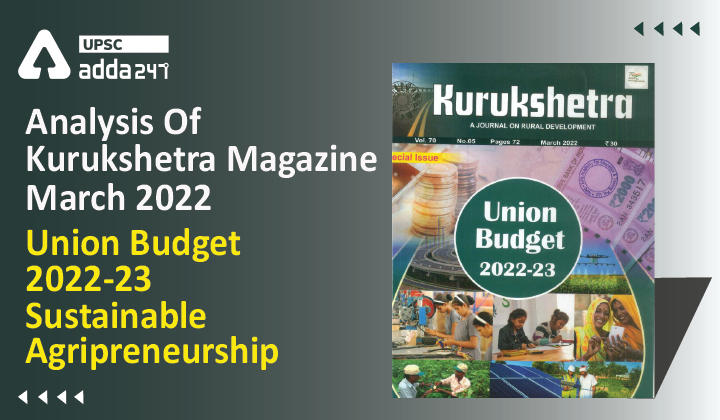Table of Contents
Analysis Of Kurukshetra Magazine: ”Union Budget 2022-23 – Sustainable Agripreneurship”
Relevance
GS 3: Inclusive Growth, Climate Change
Introduction
- In the agricultural sector, sustainable development focussing on production, value addition and marketing is of paramount importance for rejuvenation in the present scenario.
- According to the report of the Food and Agriculture Organization (FAO, 2OI7), about 20-40 per cent of crops are lost annually due to pests and diseases and as a result of lack of good monitoring system of the state of the crop.
- Government of India enhancing the use of Digital Technologies in agriculture to increase the overall efficiency of the agricultural production processes as well as the entire value chain.
- India’s National Strategy on Al also aims to realise the potential economic and social benefits the technology offers.
About Agripreneurship
- Agripreneurship converts the agricultural production system into a profitable entrepreneurial, holistic agricultural unit.
- By adopting revolutionary thoughts in agriculture and allied sectors an agripreneur who’s an innovator additionally drives the modifications in rural financial systems.
- To build up a strong framework for agriculture that should be productive, community-oriented and multifaceted, sustainable agriculture is the right choice.
- The idea of agripreneurship gives enough possibilities in agriculture and performs dynamic functions at every degree of farming.
Provisions under the budget 2022-23
- Adequate emphasis on digital infrastructure for infusion of agriculture technologies in Public-Private Partnership (PPP)modes.
- The use of Kisan Drones for crop assessments, land records, spraying of insecticides,& micronutrients, etc. will bring transformative change in the agriculture sector.
- Capital allocation towards aid for Agri and rural startups FPOs and custom machinery hiring centres.
- Promotion of chemical-free natural farming.
- Various measures have also been proposed to streamline the agri-value chain & enhance farm productivity.
What is INDIA’S pledge of Panchamrit?
- India’s pledge of panchamrit (five-fold strategy) to fight climate change, announced during the 26th Conference of the Parties (cop26) at Glasgow, Scotland, has caught global attention.
- The country’s new commitments include reaching 500 GW of non-fossil fuel energy capacity by 2030; producing 50 per cent of energy requirements via renewable energy sources by 2030; a reduction of 1 billion tonnes of carbon by 2030; reducing the carbon emission intensity of the GDP by 45 per cent by 2030; and most importantly, achieving net-zero emissions by 2070.
Conclusion
The scenario for smart farming is promising in India. Smart farming aims to increase production and improve the efficient use of land, water and other resources used in agriculture. Therefore, smart farming is the future facilitating better utilisation of precious resources, inputs and environmental protection. The key factors to succeed in smart farming in India are affordability of technology, ease of access and operations, easy maintenance of systems, timely grievance redressal and appropriate policy, support. Robust research and development in the field of smart farming are needed so that farming can empower Indian farmers to sustain their farm productivity and livelihood.



 TSPSC Group 1 Question Paper 2024, Downl...
TSPSC Group 1 Question Paper 2024, Downl...
 TSPSC Group 1 Answer key 2024 Out, Downl...
TSPSC Group 1 Answer key 2024 Out, Downl...
 UPSC Prelims 2024 Question Paper, Downlo...
UPSC Prelims 2024 Question Paper, Downlo...
